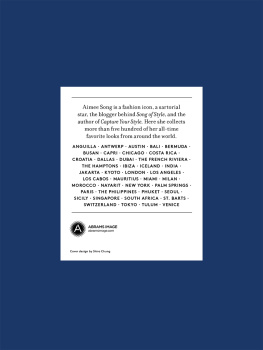The Watermans Song
OTHER BOOKS BY DAVID S. CECELSKI
Along Freedom Road: Hyde County, North Carolina,
and the Fate of Black Schools in the South (1994)
Democracy Betrayed: The Wilmington Race Riot of 1898 and Its Legacy,
co-edited with Timothy B. Tyson (1998)
William Henry Singletons Recollections of My Slavery Days,
co-edited with Katherine Mellen Charron (1999)
A Historians Coast: Adventures into the Tidewater Past (2000)
2001 The University of North Carolina Press
All rights reserved
Designed by April Leidig-Higgins
Set in Monotype Bell by Keystone Typesetting, Inc.
Manufactured in the United States of America
Publication of this work was aided by a generous grant from the Z. Smith Reynolds Foundation
The paper in this book meets the guidelines for permanence and durability of the Committee on Production Guidelines for Book Longevity of the Council on Library Resources.
Library of Congress Cataloging-in-Publication Data
Cecelski, David S. The watermans song: slavery and
freedom in maritime North Carolina / by David S.
Cecelski. p. cm. Includes index.
ISBN 0-8078-2643-X (cloth: alk. paper)
ISBN 0-8078-4972-3 (pbk.: alk. paper)
1. SlavesNorth Carolina. 2. SlaveryNorth CarolinaHistory. 3. African American ship pilots North CarolinaHistory19th century. 4. African American fishersNorth CarolinaHistory19th century. 5. Inland water transportationNorth CarolinaHistory19th century. 6. North Carolina History17751865. I. Title.
E444.N8 C43 2001 975.600496dc21 2001027125
05 04 03 02 01 5 4 3 2 1
To Tim Tyson
Contents
Map & Illustrations
MAP
Maritime North Carolina on the Eve of the Civil War
ILLUSTRATIONS
Refrain from sea chantey Sally Brown
A Chart of the Coast of North Carolina between Cape Hatteras & Cape Fear
Virginiae Item et Floridae
Their manner of fishynge in Virginia
The broyling of their fish
The Lightkeepers Boat
The Lower Banks, Outer Banks, and major sounds of North Carolina
The Albemarle Sound vicinity of Moses Grandys day
A Chart of ye West-Indies or the Islands of America in the North Sea &c
Dismal Swamp Canal
Plan of the Port of Elizabeth City
Ships caulkers
Schooner Maggie Davis
Ned, a sailor
Outpost at Shell Castle Island
Ocracock Bar including Shell Castle
William Henry Singleton
Gar, menhaden, and common eel
Mullet fishermens camp, nets, and skiff, Shackleford Banks
Shad fishermens camp, Lower Neuse River
Seaward Boat, Belvidere fishery
Going Out, Montpelier fishery
A Night Haul
Repose of Fishermen
Heading Herring
Betsy Sweat, fish cutter and cleaner
Rev. William Robinson
Wilmington harbor
Poling timber on the Dismal Swamp Canal
William Still
Thomas H. Jones
A Plan of the Town of New Bern
Cape Fear River, from Its Entrance to Smithville
Turpentine barrels at the Wilmington docks
Hiring-out bond prohibiting a slave from working on the water
Beaufort Harbour, North Carolina
Black boys on the beach near Beaufort
Gingerbread vender on the beach, Beaufort
Black crewmen on the USS Miami
Abraham H. Galloway
Purse seining for menhaden and a menhaden scrap and oil factory, Beaufort vicinity
Mullet fishermen at their camp, Shackleford Banks
preface
The Watermans Song
In October 1830 Moses Ashley Curtis arrived at the mouth of the Cape Fear River aboard a schooner from Boston. The North Carolina coast would be the young naturalists first landfall of his first voyage into the American South. Emptying into the Atlantic, the Cape Fear was a tumult of heavy waves, strong currents, and dangerous shoals. Passage across the inlets bar and outer shoals was folly without a local pilot. The schooners master raised a signal flag and beckoned toward the village of Smithville for a pilot to guide him into the river. Curtis soon spied a pilot boat under sail, breaking through the waves toward him. Approaching the schooner, the fast, elegant craft turned into the wind and drifted alongside the larger vessel. They boarded us, Curtis wrote in his diary that day, And what saw I? Slaves!the first I ever saw.
Guided into Smithville by the slave pilots, Curtis found the wharf and stores crowded with blacks, noisy and careless. After a brief stay, his schooner sailed toward Wilmington, a seaport 25 miles upriver. Unbeknownst to Curtis, this leg of his voyage was like a descent through the Cape Fear past. He sailed by Sugar Loaf, the high sand dune where colonial militia led by Colonel Roger Moore were said to have conquered the last of the Cape Fear Indians. Along the western bank of the Cape Fear River, Curtis peered into cypress swamps draped with Spanish moss. Here and there, hundreds of black hands had hewn out great rice plantations along the waters edge.
Curtis had discovered the maritime Southand the central role of African Americans within it.
When I began this study, I was no less surprised than Curtis at the degree to which slave watermen marked maritime life in North Carolina. His wordsAnd what saw I? Slaves!could have been my own. Until recently, few historians have recognized the prevalence of generations of African American maritime laborers along the Atlantic coastline. Scholars have tended to view the black South mainly in terms of agricultural slave laborpicking cotton, cutting sugar cane, winnowing rice, or priming tobacco, for examplenot trimming sails or casting nets. But in recent years a new generation of scholars has begun to explore (from different angles, in a variety of locations, and in a number of eras) the complex and important roles played by black watermen and sailors in the Atlantic maritime world.
While this research has only now begun to touch on the American South, rather than on New England and the Caribbean, nowhere was the magnitude of African American influence on maritime life greater than along the perilous seacoast and vast estuaries that stretch a hundred miles from the Outer Banks into the interior of North Carolina. The percentage of black men working full-time as fishermen or boatmen or in other maritime trades probably ranged from as little as 1 percent on the upper reaches of tidewater rivers to as much as 50 percent or more on the Outer Banks, but any firm estimate would be recklessly speculative and probably deceptive. Most coastal slaves worked on the water at least occasionally, whether it was rafting a masters timber to market once a year or fishing on the sly for their own suppers. Working on the water was a part of daily life for most tidewater slaves and their free brethren. Their preeminence in boating, fishing, and shipping can be seen again and again in contemporary newspapers, wills and estate records, plantation ledgers, ships logs, court documents, and travel accounts.

In 1830 Moses Ashley Curtis heard slave boatmen on the Cape Fear River singing this song and recorded its refrain in his diary. The piece is apparently a version of the sea chantey Sally Brown, about a beautiful Jamaican mulatto, and sailors and boatmen spread the chantey across the globe. Courtesy Southern Historical Collection, University of North Carolina at Chapel Hill.









![Othmar Keel - The Song of Songs [Song of Solomon]](/uploads/posts/book/82605/thumbs/othmar-keel-the-song-of-songs-song-of-solomon.jpg)

